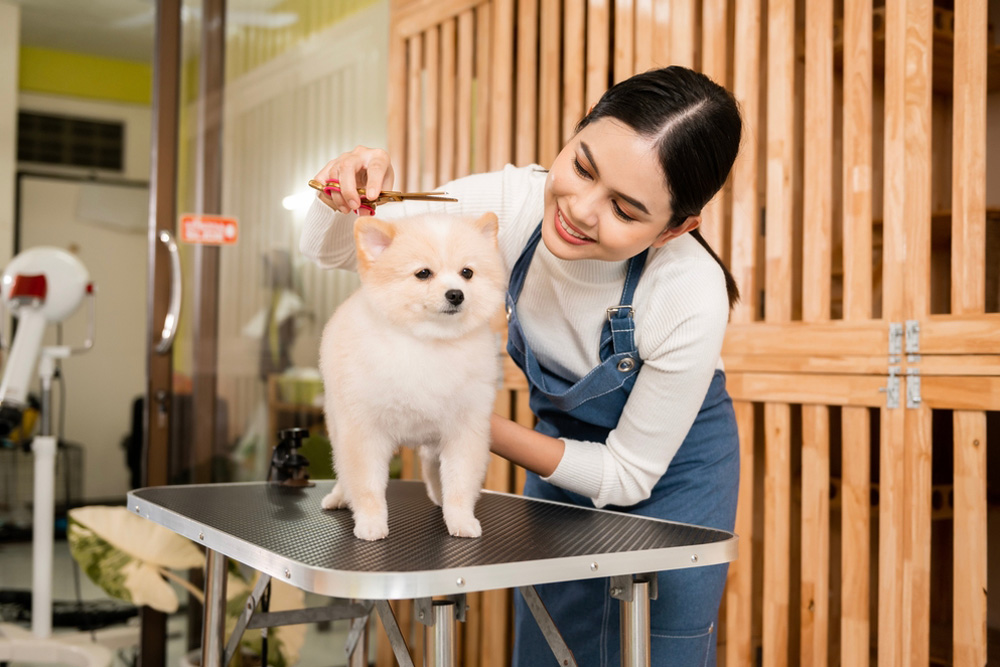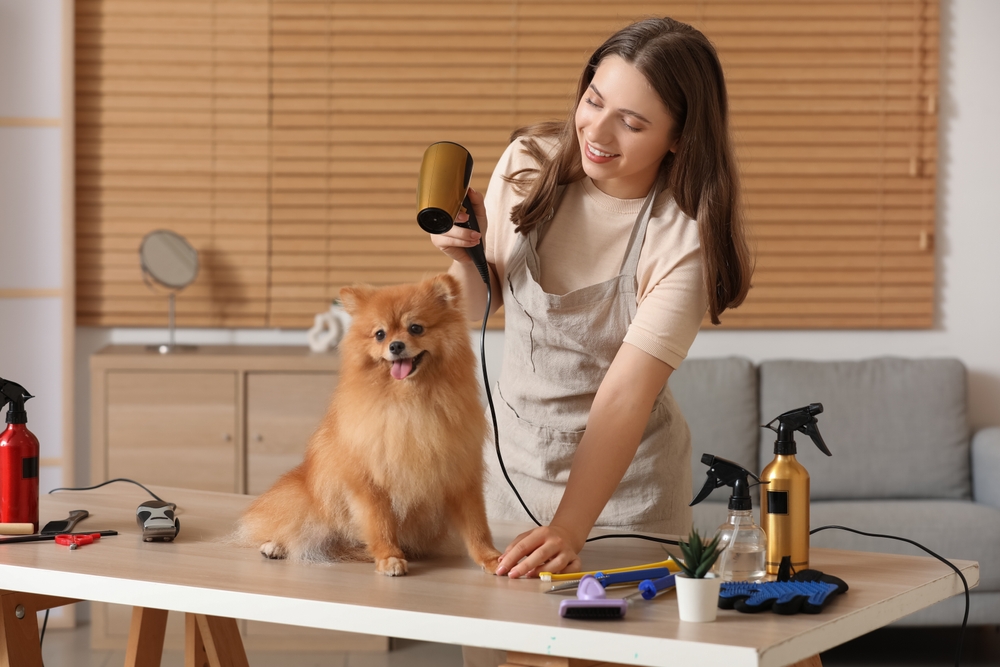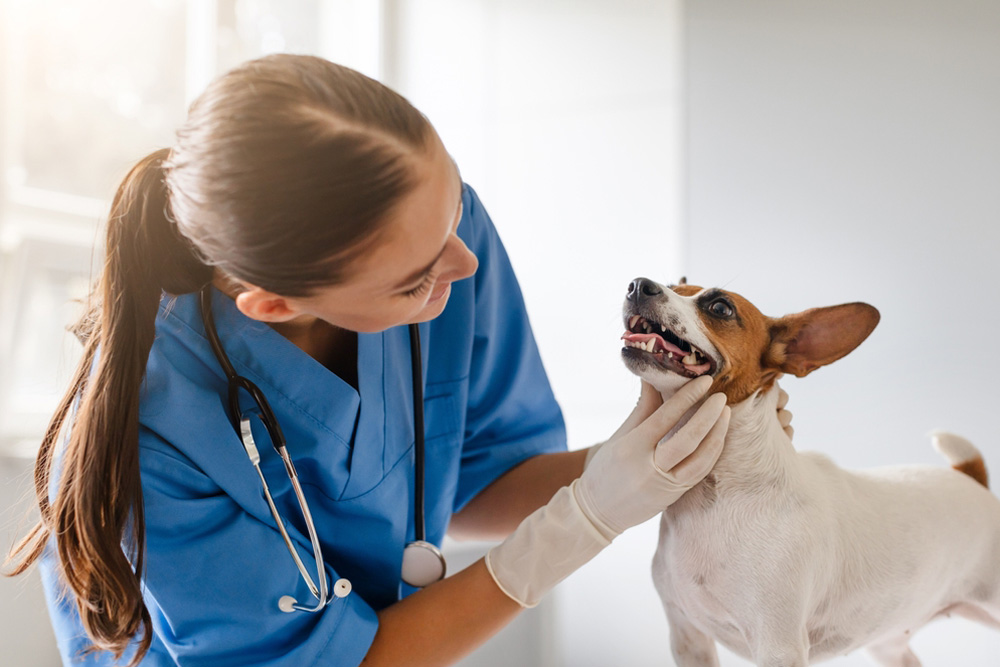
Everything you need to know about Dogs grooming
What Is Dog Grooming?
Dog grooming refers to the routine hygienic care of a dog’s body, coat, nails, ears, and overall appearance to maintain health and cleanliness. It’s more than just a cosmetic activity—it includes brushing to prevent matting, bathing to reduce dirt and allergens, trimming nails to avoid posture problems, and cleaning ears to prevent infections. While professional grooming involves trained experts using specialized equipment and breed-specific techniques, at-home grooming relies on basic tools and the owner’s consistency. The key distinction lies in expertise and scope: professional sessions often address underlying skin conditions or coat issues, whereas home care focuses on regular upkeep and bonding.

Difference Between Professional vs. At-Home Grooming
- Skill Level Need for Grooming:
- Professional grooming is performed by trained individuals familiar with breed-specific needs.
- At-home grooming is usually done by pet owners with basic knowledge and tools.
- Tools and Equipment:
- Professionals use high-quality clippers, dryers, de-shedding tools, and specialty shampoos.
- Home grooming typically involves brushes, nail trimmers, and standard grooming supplies.
- Care Needed during Grooming:
- Professional sessions include coat trimming, ear cleaning, nail grinding, anal gland expression, and skin inspections.
- Home grooming often focuses on brushing, basic bathing, and nail clipping.
- Detection of Health Issues:
- Groomers can identify early signs of infections, parasites, or skin disorders.
- Owners may overlook subtle symptoms during routine care.
- Convenience and Cost:
- Professionals save time but charge a fee.
- At-home care is budget-friendly but requires effort and consistency.

Why Is Grooming Important for Dogs?
- Health Benefits:
- Regular grooming of dogs helps maintain healthy skin and a clean, manageable coat.
- Brushing stimulates natural oil production, improving coat texture and reducing dryness.
- Nail trimming supports proper posture and prevents joint stress.
- Behavioral and Emotional Benefits:
- Grooming provides comfort and reduces physical irritants that can lead to restlessness.
- Routine grooming can improve bonding between the dog and the owner, enhancing trust.
- Dogs accustomed to grooming tend to be calmer during vet visits and social interactions.
- Prevention of Infections and Parasites:
- Cleaning ears reduces the risk of yeast or bacterial infections.
- Checking skin and coat during grooming helps identify ticks, fleas, and hotspots early.
- Brushing removes trapped debris and prevents mats, which can harbor bacteria and pests.
Should You Shave a Dog?
Shaving a dog is not a one-size-fits-all decision—it depends entirely on the breed’s coat type and the function that coat serves. Breeds with double coats, like Huskies or German Shepherds, use their layered fur to regulate temperature in both cold and warm seasons. Shaving these dogs can damage their natural insulation and expose them to sunburn or overheating. In contrast, single-coated breeds like Poodles or Maltese can be shaved for comfort or easier maintenance without compromising skin health. Understanding the structure of a dog’s coat is essential before deciding to clip it down, as improper shaving can lead to permanent coat damage or regrowth issues.
Why Nail Trimming Matters for Dogs’ Joint and Paw Health?
Overgrown nails can silently undermine a dog’s physical health by forcing unnatural posture and altering the way their feet strike the ground. When nails extend beyond a functional length, dogs tend to shift their weight backward to avoid discomfort, leading to stress in the joints, spine, and hips. This shift affects gait mechanics and can result in long-term musculoskeletal problems if left unchecked. Regular trimming keeps nails at a healthy length, preserving proper paw alignment and reducing the risk of mobility issues, especially in aging or larger breeds.
How to Keep Your Dog’s Paws Clean and Injury-Free
Dogs walk on varied surfaces—grass, gravel, asphalt, and sidewalks treated with salt or chemicals—making paw hygiene a necessary part of grooming. Cleaning paw pads after walks helps remove trapped debris, allergens, or harmful residues that can dry out or irritate the skin. Regular inspection allows early detection of cracks, burns, or embedded objects like thorns or glass. Applying a pet-safe balm after cleaning can support moisture retention and create a protective barrier, particularly in extreme weather. Clean, intact paw pads directly influence traction, comfort, and injury prevention during daily activity.
Dental Hygiene
Oral care is often overlooked in routine dog grooming, yet it plays a critical role in preventing periodontal disease, tooth loss, and systemic infections. Brushing a dog’s teeth with canine-specific toothpaste helps reduce plaque buildup and curb bacterial growth that causes bad breath and gum inflammation.

How Often Should You Brush Your Dog’s Teeth?
Brushing your dog’s teeth at least two to three times per week helps remove plaque before it hardens into tartar, which is more difficult to eliminate without veterinary tools. For optimal oral health, daily brushing is recommended—especially in smaller breeds or those genetically predisposed to gum disease. Using a toothbrush designed for dogs, along with canine-safe toothpaste, ensures cleaning without harming enamel or gut health. Consistent brushing not only keeps breath fresh but also lowers the risk of gingivitis, tooth decay, and oral bacteria that can enter the bloodstream and affect internal organs.
Do Dental Treats and Chews Actually Work?
Dental treats and textured chews offer mechanical abrasion that helps reduce soft plaque and massage the gums during chewing. While not a substitute for brushing, they can complement oral care—especially in dogs resistant to manual cleaning. The effectiveness of dental chews depends on their hardness, shape, and ingredients; treats approved by veterinary dental associations tend to perform better in plaque control. Some chews also include enzymes or breath-freshening agents, adding antimicrobial benefits. However, treats should be seen as supportive tools—not standalone solutions—for maintaining a dog’s dental hygiene.
How to Clean Tear Stains and Protect Your Dog’s Eye Health
Tear stains often appear as reddish-brown marks beneath a dog’s eyes, especially in light-colored breeds like Maltese or Shih Tzus. These stains are caused by excessive tearing, which may result from blocked tear ducts, allergies, or eye irritation. Cleaning the area gently with a damp cloth or vet-approved eye wipes can help prevent bacterial buildup and discoloration. It’s also important to check for signs of infection—such as yellow discharge, swelling, or excessive blinking—which may require veterinary attention. Regular inspection ensures clear vision and reduces the risk of chronic eye conditions.
How Often Should You Clean Your Dog’s Ears?
The frequency of ear cleaning depends on your dog’s breed, ear shape, and activity level. Dogs with floppy ears or heavy fur around the ear canal—like Cocker Spaniels or Basset Hounds—may require weekly cleaning due to limited airflow, which encourages moisture buildup. For others, biweekly or monthly maintenance may be sufficient. Use a vet-recommended ear cleaning solution and cotton gauze to wipe the visible inner ear without inserting anything deep into the canal. Look out for signs of trouble such as redness, odor, or excessive scratching, which could indicate infection or ear mites requiring medical treatment. Clean ears help prevent inflammation, discomfort, and recurring ear problems.
How Often Should You Bathe Your Dog and Which Shampoo Is Safe?
Bathing schedules depend on breed, skin type, and lifestyle, but most dogs benefit from a bath every four to six weeks. Over-bathing can strip natural oils, leading to dry, irritated skin, while under-bathing may allow dirt, allergens, and odor to accumulate. Always use a dog-specific shampoo that matches the skin condition—oatmeal-based for sensitive skin, antifungal for infection-prone dogs, or hypoallergenic for allergy management. Human shampoos, even mild ones, are too acidic for canine skin and can cause imbalance. Bathing is not just about cleanliness—it’s a preventive step in managing skin health, coat quality, and odor control.
When and Why Is Deworming Important for Dogs?
Deworming is a critical part of preventive health care, protecting dogs from internal parasites such as roundworms, hookworms, and tapeworms. Puppies are particularly vulnerable and typically require deworming every few weeks during early development, while adult dogs follow a maintenance schedule based on lifestyle and risk exposure. Worm infestations can lead to weight loss, diarrhea, vomiting, and nutrient deficiencies, even if no symptoms are initially visible. Deworming tablets or chewables prescribed by a veterinarian help eliminate parasites before they cause damage, and routine fecal exams ensure the treatment remains effective. Consistent deworming also reduces the risk of zoonotic transmission to humans, especially in households with children.
How to Prevent Fleas and Ticks Without Harming Your Dog’s Skin
Fleas and ticks pose not just a nuisance but a serious health risk, potentially transmitting diseases like Lyme or tapeworms. Preventive care should be both effective and skin-safe, especially for dogs with sensitivities. Spot-on treatments, oral medications, and tick collars are common options, but it’s important to choose products based on your dog’s weight, breed, and medical history. Natural repellents, like diluted essential oils or herbal sprays, may offer mild protection but require frequent reapplication. Regular checks after outdoor activity—especially in warm seasons—allow early removal of ticks before they embed. A well-maintained coat and clean sleeping areas also reduce the chance of infestation.
Is It Better to Groom Your Dog at Home or Visit a Professional?
Choosing between home grooming and professional services depends on your dog’s temperament, coat type, and your comfort with handling grooming tasks. At-home grooming allows for flexible scheduling, lower long-term costs, and bonding time with your pet. However, it requires a learning curve and may fall short for complex needs like breed-specific cuts, anal gland expression, or dealing with anxious dogs. Professional groomers bring expertise, specialized equipment, and a trained eye to spot early health issues. For dogs with thick coats, recurring skin problems, or behavioral challenges, professional sessions often ensure more thorough care and fewer grooming-related injuries.
What Tools Do You Need to Groom Your Dog at Home?
Effective home grooming starts with the right set of tools tailored to your dog’s coat type and grooming needs. A slicker brush or de-shedding tool is essential for removing loose fur and preventing mats, while a stainless-steel comb helps reach deeper layers in long-haired breeds. Nail clippers with a safety guard, or a nail grinder for smoother edges, support safe trimming. Canine-specific shampoos, ear-cleaning solutions, and cotton pads ensure hygienic care without irritating the skin. Rounded-tip scissors help with sanitary trims around sensitive areas. Investing in a non-slip mat and a quiet hairdryer can also make the experience more controlled and less stressful for both dog and owner.
How Often Should You Groom Your Dog?
The frequency of dog grooming varies based on breed, coat type, and seasonal changes. Short-haired breeds like Boxers or Beagles typically need grooming every 4 to 6 weeks, while long-haired or double-coated dogs like Golden Retrievers and Huskies may require weekly brushing and monthly baths to prevent matting and seasonal shedding. Breeds with fast-growing hair, such as Poodles or Shih Tzus, often need full grooming every 3 to 4 weeks to maintain coat shape and skin hygiene. During warmer months or shedding seasons, more frequent sessions help manage fur buildup and keep dogs comfortable. Adjusting your grooming schedule to match your dog’s biology and environment ensures both hygiene and comfort are consistently maintained.


